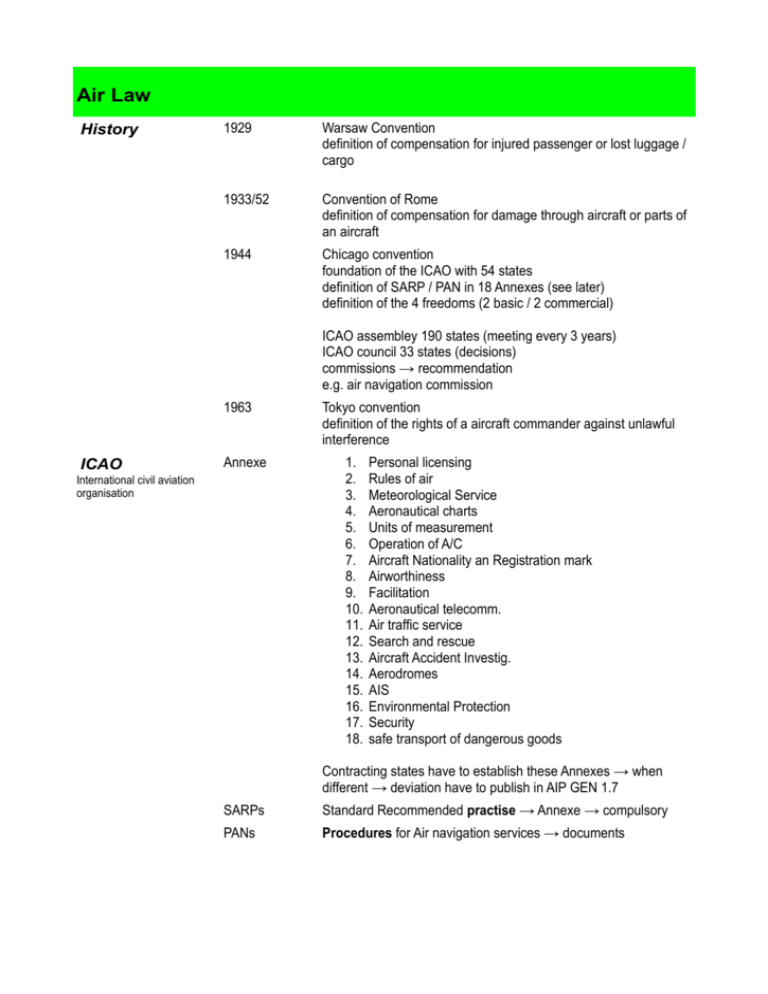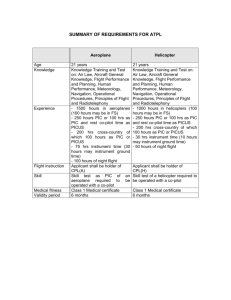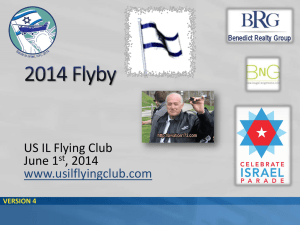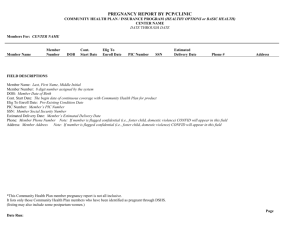Air Law - Andreas Lammering
advertisement

Air Law History 1929 Warsaw Convention definition of compensation for injured passenger or lost luggage / cargo 1933/52 Convention of Rome definition of compensation for damage through aircraft or parts of an aircraft 1944 Chicago convention foundation of the ICAO with 54 states definition of SARP / PAN in 18 Annexes (see later) definition of the 4 freedoms (2 basic / 2 commercial) ICAO assembley 190 states (meeting every 3 years) ICAO council 33 states (decisions) commissions → recommendation e.g. air navigation commission 1963 ICAO Annexe International civil aviation organisation Tokyo convention definition of the rights of a aircraft commander against unlawful interference 1. 2. 3. 4. 5. 6. 7. 8. 9. 10. 11. 12. 13. 14. 15. 16. 17. 18. Personal licensing Rules of air Meteorological Service Aeronautical charts Units of measurement Operation of A/C Aircraft Nationality an Registration mark Airworthiness Facilitation Aeronautical telecomm. Air traffic service Search and rescue Aircraft Accident Investig. Aerodromes AIS Environmental Protection Security safe transport of dangerous goods Contracting states have to establish these Annexes → when different → deviation have to publish in AIP GEN 1.7 SARPs Standard Recommended practise → Annexe → compulsory PANs Procedures for Air navigation services → documents ATS Three parts annex 11 1. ATC – Air traffic control Parts Aerodrome Approach (including Departure) Area 2. FIS – Flight information service 3. Alerting service Basic: FIS + Alerting service Alerting service Frequencies: 121.5 MHz, 234 MHz and ELT 406MHz ELT = emergency location transmitter Action-chain: Operational FIC / ATCU - collect information → RCC (Rescue coordination centre) – evaluate information → activate appropriate action for example SAR 3 Phase of alerting Uncertain phase (INCERFA) – Evaluation establish: no communication within 30 min. or no arrival with in 30 min. after ETA Alert phase (ALERFA) – Alert SAR Units establish: A/C fails to land within 5 min. after clearance and no communication a/c know or believed to be subject of unlawful interference can triggered by operational ATCU/FIC and RCC Distressphase (DETRESFA) – send out SAR establish: certainly that a/c and occupants are threatened by serious Fuel on board is considered to be exhausted Separation Types Vertical – 1000 ft RVSM up to FL410 (incl), 2000ft above horizontal - lateral or longitudinal composite by ATC by pilots: only VMC Lateral sep VOR: 15° Course divergence NDB: 30° course divergence DR fix 45° Track divergence Longitudinal Standard: 15 min. Nav-Aids: 10 min. 2 A/C same nav aid : 5 min. if preceding is 20kt faster 3 min. if preceding is 40kt faster DME Standard: 20NM, 10NM if preceding A/C 20kt faster Crossing: same like standard Machnumber Standard: 10 min Reduction if preceding A/C is faste Mach difference: 0-0.01 10, +0.01 Mach → minus 1 minute Crossing Tracks without nav: 15 min with nav: 10 min Climb / descent Without nav: 15 min with nav aid (VOR): 10 min Vertical If no lateral separation – vertical separation at least 10min befor crossing. Approach Medium behind heavy – 2 min light behind medium / heavy – 3 min Departure Light / medium behind heavy or light behind medium 2 minutes increased to 3 min if departure from Intersection. Radar Minima → 5NM Terminal radar within 40NM of Radar Head → 3NM ILS Localizer within 10 NM of threshold → 2.5NM Parallel approach → 2 NM if continued to threshold – 4NM radar contact lose not more than 5 seconds First a/c at scene has to charge information and transmit to ATCO SAR Annex 12 care packet RED – medical equipment BLUE – Food and Water YELLOW - blankets and clothing BLACK – other things special communication symbols (pic ) Investigation objective → prevent same accident in the future Accident investigation annex 13 Accident definition 1. 1 person is seriously or fatal injured being in a/c, in direct contact or jet blast 2. sustaining damage or structural failure of a/c 3. A/c missing or completely inaccessible Serious incident Nearly the same like an accident but without the consequences Nationality marks and regestration mark Nationality mark International Telecommunication Agency gives a state an unique Nationality mark. State hand on this to the aircraft. Special: Common mark for aircraft which owned by a company and it is not possible to determine a registration state. 4YA – 4YZ reserve for such cases Only example: Arab Air Cargo (iraq/ jordan – 4YB) annex 7 International Telecommunication Agency → ICA common mark agency → contracting state → aircraft Registration mark State responsible Combinations Roman letter and General Five letter Nation : Registration → 1:4,2:3,3:2 USA is special prohibited combinations 5 Letter combination used in international Signal 3 Letter which based on the Q-Code (QNH, QDM....) Distress and urgency signals (SOS, PAN,...) Size Certificate of Registration 50 cm under wing 30 cm on the fuselage (position left side last part) 50 cm for balloons Always on board – name the address of the owner there is no Identification mark in Aerodromes annex 14 Aerodrome Only for design and planning purpose reference code Letter + Number Code Aeroplane ref Code Wing span no field length (m) letter (m) Outer main gear (m) 1 X < 800 A x<15m X<4.5m 2 800<=x<1200 B 15<=x<24 4.5<= x<6 3 1200<=x1800 C 24<=x<36 6<=x<9 4 x>=1800 D 36<=x<52 9<=x<14 Distance for take off with: E ISA, MTOW, zero wind F 50<=x< 65 9<=x<14 65<=x<80 14<=x<16 Runway width Code A no B C D E F 1* 18 18 23 - - - 2* 23 23 30 - - - 3 30 30 30 45 - - 4 45 45 45 60 * with precision approach RWY should be in any case 30m Aerodrome reference point → normal middle of longest rwy or geometric center of airport Runway types Non-precision (visual) runway instrument runway – 1. precision runway (ILS, MLS...) 2. non-precision rwy (DME app., Localiser appr. ...) Take-off or landing runway Declared concepts (pic) Take off run available (TORA) runwaylength able to roll Take off distance available (TODA) rwylength avail. to reach 35ft(dry) / 15ft(wet) can increase by clearway Accelerated stop dist.available (ASDA) length available to stop – can increase by stopway Landing distance available (LDA) same like TORA or shorter never more than TORA Markings pic Markings are painted on the ground Marking element Visual rwy non-precision precision Designator yes yes Centerline yes yes Threshold yes yes yes Sign Aiming Point recommen yes ded Touchdown zone - - Side stripes - - Mandatory sign (red back / white letter) information sign 1. locator sign ( black back / yellow letter) 2. direction sign (yellow back / black letter) Lights Aerodrome Aeronautical / airport beacon rotating white / green light on a elevated position Identification beacon green flashing light / land airport (flashing the letter code - morse) red flashing (military) Approach Non precision rwy simple approachlight 900m centreline 300m from threshold a crossbar precision rwy 1 ICAO barrettes system 2 Calvert System (Great Britain) Barrette system 5 lights = one barrette 900m centre line consist of barrettes (3 lights!) one crossbar at 300m from threshold Obstacle Calvert system 900m centreline first 300m – 3 lights sec. 300M – 2 lights last 300m before th. - 1 light 5 crossbars (every 150m) Taxiway Centrelight – fixed green edge lights – fixed blue PAPI Precision approach Path indicator (4 lights) 2 white – 2 red → okay 1 white – 3 red → 0.5° to low / 3 white – 1 red → 0.5° to high APAPI – abbreviated PAPI (2 lights) REIL Runway end identification light white flashing light at the threshold. Objects <45 m Low intensity red <90 m Medium intensity red or white if not clearly visible by day: high intensity white <150m Low intensity red by night 3 intervals á 45m from top Over 150 Emergency Fire fight cath. AIS / AIP / AIRAC AIS High intensity white by day 1-10 depends on the biggest aeroplan (length and width of fuselage) Aeronautical information service provides a preflight information service Integrated aeronautical information package ( IAIP) includes PIB – preflight information bulletin last approved flight plan important NOTAMs NOTAM Information about temporary changes in procedures etc. closed rwy, military exercise, temp. obstacles, Hazards (airshow) temp. flight restrictions special Notams SNOWTAM vaild for 24h send when runway is contaminated (25% of rwy with 3mm equivilant water) uncleared part of runway explained in plain language. BIRDTAM ASHTAM – Red (Ash about FL250), orange (Ash under FL250, yellow (some action), green AIP Aeronautical Information puplication Three parts: GENeral ENRout containing information of an administrative and explanatory nature (e.g.) meteorological Service Updates with: Amendments AMDT lasting character AIRAC AMDTs contains information concerning airspace and its use (Restricted areas) AEROdromes contains information concerning aerodromes and their use Supplements temporary character (but more than 3 month) AIRAC Supplements AIRAC – Aeronautical Information Regulation and Control is an procedure to introduce main changes. Main changes in Procedures have to announce 28 before. ATS sends the changes 6 Weeks before to every AIP holder. AIC Aeronautical Information circuls information which do not fit to AIP neither NOTAM Security NCASP National civil aviation security procedures are recommended by ICAO → states develop such NCASP → operator have to realize this Weapons General weapons on board have to prevent special authorized persons allowed, but commander has to inform about the no. and the seats of these persons Hijacking Support of state minimum this means: Navigation aids Isolated parking 100m away from nearly everything A/c should be grounded unless human life is in danger in flight choose a ALT/ FL differs 500ft below and 1000ft above FL290 ATIS Automatic Terminal Information service Can broadcast via VOR, but not via ILS or on own frequencies is provided by ATS contains weather and aerodrome information (rwy in use etc.) should not exceed 30 seconds. VOLMET Summary frequency for the ATIS from main airports. AIRREP Format 1 Section Flight information Annex 17 Personal Licensing 2 Section 3 Section ETA and Endurance weather JAR FCL JAR- FCL 1 – Airplanes JAR-FCL 2 – Helicopter JAR-FCL 3 – Medical JAR-FCL 4 – controller Medical Validity Class Annex 1 Time (month) 1 Two men, commercial Up to 60 - 12 above - 6 1 One men commercial 2 Up to 40 – 12 above - 6 Up to 40 -60 up to 50 (ICAO 60) – 24 above (ICAO 60) - 12 Deferment: in case of remote from location ONLY ICAO single periode 6 month – non-commercial aviation twice 3 month for commercial aviation 24 month for PPL- Holder Illness authority has to be informed of any illness longer 21 days and hospital stay longer than 12h License PPL minimum age 17 total flight time Dualinstruction solo time cross country CPL minimum age 18 Modular course PIC time cross country instrument instruction night flight 45 h ( max. 5h on FNPT) 25h 10 h min. incl. 5H cross county 150 NM incl. 2 landings 200h (integrated 150h) 100h (integrated 70h) 20h as PIC, 300NM triangle 10h (max. 5h ground instruments) 5h (incl 5 T/Os and landing as PIC ATPL minimum age 21 Flight time 1500h simulator time 100h max. multi pilot 500h PIC 250h or 100h PIC and 150h as co-pilot performing as PIC duties under supervision cross country 200h (100h as PIC or copilot performing as PIC US) instruments 75h ( max 30h instrument ground) Night flight 100h as PIC or Co-Pilot Credit flight time PIC or PIC under supervision Credit full: solo, dual instruction, PIC time Checks LPC – Line Proficiency Check – every 12 month OPC- operator proficiency Check – every 6 month line check – normal flight – every 12 month all is possible 90 before license runs out. Airworthiness Annex 8 Certification standards Certification standards of airworthiness JAR 23/25 next time EASA CS 23/25 JAR 23 normal, utility, aerobatic and commuter aircraft MTWO < 5.670kg , seat <= 9 Propeller twin engine, seats <= 19, MTWO <=8.618kg JAR 25 all other multi engine jets Certificate of Airworthiness Issued an renewed by the law of state of registration not allowed to fly without a C.o.A. Has to be always on board. (in commercial display to the pax) no name printed , but aircraft cathegorie in case of small damage the state of registration can allow to fly without fixing Facilitation Documents 1. General declaration operator, registration, insurance, no of pax 2. Passenger manifest name, place of birth, crew only no. Cargo manifest list of no and nature, additonal information, airway bill 3. Simple stores list things which remain on the aircraft (food, duty free etc.) Visa ICAO intention: Passenger should only need a valid passport Annex 9 Visa not required for connection flights ( transit zone) OIS Medical req. Required a yellow fever protection for trips in danger zones Possibility of quarantine in case of yellow fever, plague, cholera Baggage Oral declaration of content an ownership sufficient Inspection of baggage just for aviation security Crew Crew member certificate CMC valid by the operator, content: Name of operator, photography Inadmissible persons Operator responsible Deportees Every state can deport or extradite foreign national citizens with an aircraft. Operator has to inform → operator informs commander Obstical identification surface It is a area with a diameter of 15km and insures a MOC for the runway. Middle more → boundary less PDG – procedures design grade (pic) MDH Minimum descent hight / altitude OC + MOC + “Operator height” Operator height depends on: a/c equipment, personal skill, approach type MSA Minimum safe altitude 1000ft difference to a obstacle in a range of 25NM around a specific point can be different heights in one circle SID Standard instrument departure reflect noise abatement require nav aids (VOR/NDB and DME) GNSS SiD called RNAV SID route < 25NM SID controlled by approach SID is a track → pilots have to correct for known wind SID always have a unique identifier straight departure → centreline +- 15° deviation 0ft MOC at DER , PDG 3.3% turn departure → centreline more than 15° deviation turning departure speeds Aircraft Vref Max turn speed A <91kt 120 B 91/120 165 C 121/140 265 D 141/165 290 E 166/210 360 Normal approach: 3° steep approach: 3.5° - 6.5° special qualification Circling appr. Final of an instrumentenapproach conditions rwy have to be in sight → not normal missed approach proc. Take off altern. For low visibility approach → landing requirements are perhaps higher Holding 2 engine 1h in still air 3 engine 2h in still air ETOPS 1h in still air Alternate has to full fill the requirements IFR – Holding normally right turns VFR – Holding normally left turns Time Altitude speed 1:00 min. < 14,000 ft 230kt 1:30 min. 14,000 – 20,000 ft 240kt 1:30 min. 20,000-34,000 ft 265kt 01:30 min. > 34,000ft 0.83 M Timing starts with abeam fix (pic. 9.) MHA: minimum holding altitude EUROCONTROL Flow management En-route slots - Brüssel Airport slots - aerodromes slot: 15 min → 5min before and 10 min. after CTOT CTOT: calculated Take-off time Flight Rules Changeover point If not other specified 60NM or more VFR CTR A/D minimas: 1500ft ceiling / 5 km visibility IFR Minimum flight level: No MH given: 1000ft above highest obstacle within 8km(5NM)





